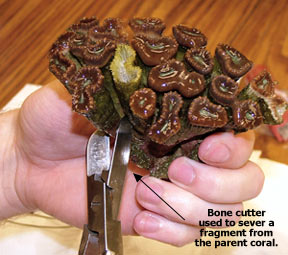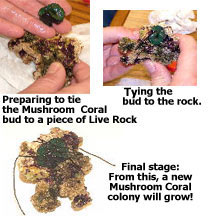
As reef aquariums gain popularity, the amount of knowledge regarding the husbandry of corals steadily increases, developing better and more successful techniques. However, understanding and replicating conditions that induce coral spawning is still an elusive aspect of coral care. It is still uncommon for corals to spawn in the home reef aquarium. Luckily, corals employ more than one reproductive strategy to propagate. Though sexual reproduction is yet uncommon, asexual reproduction is extremely common in a well-maintained home reef aquarium.
By taking advantage of this unique propagative strategy, with patience, dedicated reef hobbyists are able to essentially fill an aquarium with just a few parent corals. Coral propagation is a cost effective way to have more corals, but more importantly, it helps alleviate the demand placed on corals harvested from the ocean.
Asexual Reproduction
When proper environmental conditions are present (for example, appropriate water parameters, water movement, water temperature, lighting conditions, calcium level, etc.), corals thrive and multiply naturally in the home aquarium. The most common form of asexual reproduction exhibited by corals is "budding," where an offshoot is formed from the parent coral. During the budding process, a new coral (bud) is produced, usually at the growing edge of the parent coral. As the offshoot grows and the budding process continues, a small colony of new corals begins to develop and grow off of the parent coral.
In the ocean, the detachment of the newly formed coral buds is often caused by strong water currents, physical trauma, or biological triggers. The exact length of time varies from species to species, but the bud, or offshoot, eventually detaches from the parent coral and settles in a new location.
 Human Intervention
Human Intervention
The division and separation of buds occur naturally in well-maintained reef aquariums. However, the process can be lengthy and rather unpredictable. The seasoned or dedicated hobbyist can take matters into his own hands and divide existing corals. Mushroom Corals and Colony polyps such as Xenia are among the easiest corals to propagate since the development and attachment site of each bud is clearly visible.
A clean cut is made to sever the bud from the parent coral utilizing a sharp pair of
tissue scissors or
bone cutters. It is crucial to incorporate a single motion rather than multiple snipping motions to ensure a clean cut for faster healing. Be sure to make the cut at the base of the coral bud where it attaches to the parent coral. If the distinction between parent and bud is not clear and you do not feel comfortable, wait until the bud matures and the distinction is clear. The severed bud can then be attached to a small piece of live rock. Use monofilament or nylon fishing line to gently, yet tightly, secure the coral to the live rock. Position the coral in an appropriate location with regard to lighting and water movement.
Provide and maintain ideal water conditions to ensure healthy growth. In due time, the new coral will mature and fill out nicely. As long as the corals are provided for, this process can be repeated indefinitely – resulting in a well-stocked reef aquarium from just a few parent corals.
|
Asexual reproduction – Reproduction that occurs without the exchange of sperm and eggs.
Budding – The formation of tissue extensions (offshoots) attached to the parent coral, developing into new, fully formed corals.
Clone – An organism that is produced with the identical genetic make-up as the original.
Fragmentation – The formation of new corals (usually the growing tips on hard corals) resulting from broken pieces of the parent coral. |
Products Helpful in Coral Propagation:
Commonly Fragged Corals:
|